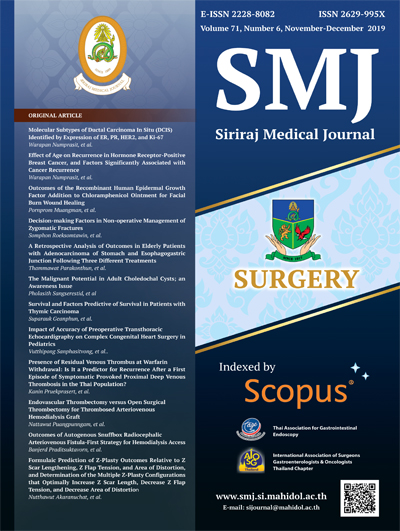Molecular Subtypes of Ductal Carcinoma In Situ (DCIS) Identified by Expression of ER, PR, HER2, and Ki-67
DOI:
https://doi.org/10.33192/Smj.2019.64Keywords:
Clinicopathological features; ductal carcinoma in situ; molecular subtypes; prevalenceAbstract
Objective: The estrogen receptor (ER), progesterone receptor (PR), human epidermal growth factor receptor 2 (HER2), and Ki-67 are used to classify invasive breast cancer into various subtypes. In the case of ductal carcinoma in situ (DCIS), however, the information relating to subtypes using these markers is still limited.
Methods: The pathological specimens of 267 patients diagnosed with DCIS at Siriraj Hospital were analyzed. By using the expressions of ER, PR, HER2, and Ki-67, breast cancer patients were classified into the five molecular subtypes: luminal A, luminal B/HER2 negative, luminal B/HER2 positive, HER2 overexpression, and triple-negative. Based on the specific molecular subtypes, age, clinical presentation, tumor size, and tumor grade were analyzed separately using univariate analysis.
Results: 135 (50.6%), 1 (0.4%), 58 (21.7%), 59 (22.1%), and 14 (5.2%) DCIS were luminal A, luminal B/HER2 negative, luminal B/HER2 positive, HER2 overexpression, and triple-negative, respectively. Patients with luminal A DCIS significantly presented with mass, compared to the other subtypes that displayed with mass and microcalcification in combination (p = 0.008). The luminal A subtype was also associated with tumors of a smaller size (less than 2 cm; p = 0.007) and a lower nuclear grade (p = 0.000) than the HER2 overexpression subtype.
Conclusion: Although luminal A DCIS was the most common DCIS subtype of Thai women, HER2 overexpression DCIS was significantly correlated with poor clinicopathological features, including a large tumor size and a high nuclear grade, which are recognized prognostic factors for tumor recurrence.
Downloads
Published
How to Cite
Issue
Section
License
Users are free to share, copy, and redistribute all articles published in the Siriraj Medical Journal (SMJ) in any medium or format as long as you follow the following terms:
- Attribution — You must give appropriate credit, provide a link to the material, and indicate if changes were made. You may do so in any reasonable manner, but not in any way that suggests the publisher endorses you or your use.
- NonCommercial — You may not use the material for commercial purposes.
- NoDerivatives — If you remix, transform, or build upon the material, you may not distribute the modified material.
- No additional restrictions — You may not apply legal terms or technological measures that legally restrict others from doing anything the license permits.











